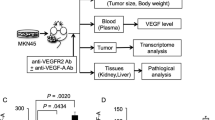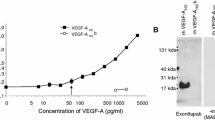Summary
Angiogenesis, the process by which new blood vessels form from existing vasculature, is critical for tumor growth and invasion. Growth factors, such as VEGF, initiate signaling cascades resulting in the proliferation of resting endothelial cells. Blockade of growth factor pathways has proven effective in inhibiting angiogenesis and tumor growth in vivo. Integrins, including the integrin α5β1, are also important mediators of angiogenesis and these adhesion molecules also regulate cancer cell growth and migration in vitro. Volociximab is a high affinity, function-blocking antibody against integrin α5β1 that is currently in multiple Phase II oncology clinical trials. Volociximab displays potent anti-angiogenic activity in a monkey model of choroidal neovascularization. In this study, we explored the consequences of integrin α5β1 blockade on tumorigenesis. Because volociximab does not cross-react with rodent α5β1, the syngeneic rabbit VX2 carcinoma model was utilized as an alternative to standard mouse xenograft models for the assessment of anti-tumor activity of volociximab. Volociximab administered intravenously to rabbits bearing VX2 tumors is detectable on tumor cells and vasculature 45 min post-administration. Volociximab was found to significantly inhibit the growth of tumors growing subcutaneously or intramuscularly, despite a 20-fold lower affinity for rabbit integrin, relative to human. This effect was found to correlate with decreased blood vessel density within these tumors. These results support the use of volociximab in the intervention of malignant disease.




Similar content being viewed by others
References
Folkman J (2003) Fundamental concepts of the angiogenic process. Curr Mol Med 3:643–651
Hynes RO (2002) Integrins: bidirectional, allosteric signaling machines. Cell 110:673–687
Stromblad S, Cheresh DA (1996) Integrins, angiogenesis and vascular cell survival. Chem Biol 3:881–885
Giancotti FG, Ruoslahti E (1999) Integrin signaling. Science 285:1028–1032
Hynes RO, Lively JC, McCarty JH, Taverna D, Francis SE, Hodivala-Dilke K, Xiao Q (2002) The diverse roles of integrins and their ligands in angiogenesis. Cold Spring Harbor Symp Quant Biol 67:143–153
Lee BH, Ruoslahti E (2005) alpha5beta1 integrin stimulates Bcl-2 expression and cell survival through Akt, focal adhesion kinase, and Ca2+/calmodulin-dependent protein kinase IV. J Cell Biochem 95:1214–1223
Khalili P, Arakelian A, Chen G, Plunkett ML, Beck I, Parry GC, Donate F, Shaw DE, Mazar AP, Rabbani SA (2006) A non-RGD-based integrin binding peptide (ATN-161) blocks breast cancer growth and metastasis in vivo. Mol Cancer Ther 5:2271–2280
Kim S, Bakre M, Yin H, Varner JA (2002) Inhibition of endothelial cell survival and angiogenesis by protein kinase A. J Clin Invest 110:933–941
Maglott A, Bartik P, Cosgun S, Klotz P, Ronde P, Fuhrmann G, Takeda K, Martin S, Dontenwill M (2006) The small alpha5beta1 integrin antagonist, SJ749, reduces proliferation and clonogenicity of human astrocytoma cells. Cancer Res 66:6002–6007
Sudhakar A, Sugimoto H, Yang C, Lively J, Zeisberg M, Kalluri R (2003) Human tumstatin and human endostatin exhibit distinct antiangiogenic activities mediated by alpha v beta 3 and alpha 5 beta 1 integrins. Proc Natl Acad Sci USA 100:4766–4771
Yi M, Ruoslahti E (2001) A fibronectin fragment inhibits tumor growth, angiogenesis, and metastasis. Proc Natl Acad Sci USA 98:620–624
Ramakrishnan V, Bhaskar V, Law DA, Wong MH, DuBridge RB, Breinberg D, O’Hara C, Powers DB, Liu G, Grove J, Hevezi P, Cass KM, Watson S, Evangelista F, Powers RA, Finck B, Wills M, Caras I, Fang Y, McDonald D, Johnson D, Murray R, Jeffry U (2006) Preclinical evaluation of an anti-alpha5beta1 integrin antibody as a novel anti-angiogenic agent. J Exp Ther Oncol 5:273–286
Rous P, Kidd JG, Smith WE (1952) Experiments on the cause of the rabbit carcinomas derived from virus-induced papillomas. II. Loss by the Vx2 carcinoma of the power to immunize hosts against the papilloma virus. J Exp Med 96:159–174
Ling R, Li Y, Yao Q, Chen T, Zhu D, Jun Y, Chen J (2005) Lymphatic chemotherapy induces apoptosis in lymph node metastases in a rabbit breast carcinoma model. J Drug Target 13:137–142
Phillips PC, Than TT, Cork LC, Hilton J, Carson BS, Colvin OM, Grochow LB (1992) Intrathecal 4-hydroperoxycyclophosphamide: neurotoxicity, cerebrospinal fluid pharmacokinetics, and antitumor activity in a rabbit model of VX2 leptomeningeal carcinomatosis. Cancer Res 52:6168–6174
Tanaka H, Taniguchi H, Mugitani T, Koishi Y, Masuyama M, Higashida T, Koyama H, Suganuma Y, Miyata K, Takeuchi K et al (1995) Intra-arterial administration of the angiogenesis inhibitor TNP-470 blocks liver metastasis in a rabbit model. Br J Cancer 72:650–653
Sano B, Sugiyama Y, Kunieda K, Sano J, Saji S (2002) Antitumor effects induced by the combination of TNP-470 as an angiogenesis inhibitor and lentinan as a biological response modifier in a rabbit spontaneous liver metastasis model. Surg Today 32:503–509
Magnussen A, Kasman IM, Norberg S, Baluk P, Murray R, McDonald DM (2005) Rapid access of antibodies to alpha5beta1 integrin overexpressed on the luminal surface of tumor blood vessels. Cancer Res 65:2712–2721
Brooks PC, Stromblad S, Klemke R, Visscher D, Sarkar FH, Cheresh DA (1995) Antiintegrin alpha v beta 3 blocks human breast cancer growth and angiogenesis in human skin. J Clin Invest 96:1815–1822
Kim KJ, Li B, Winer J, Armanini M, Gillett N, Phillips HS, Ferrara N (1993) Inhibition of vascular endothelial growth factor-induced angiogenesis suppresses tumour growth in vivo. Nature 362:841–844
Acknowledgements
We thank Dr. John Hilton at John Hopkins University for in vivo passaged VX2 cells and advice, Eric Ibsen for animal handling and technical assistance and Dr. Dian Olson and Dr. Patricia Culp for critical review of the manuscript.
Author information
Authors and Affiliations
Corresponding author
Rights and permissions
About this article
Cite this article
Bhaskar, V., Fox, M., Breinberg, D. et al. Volociximab, a chimeric integrin alpha5beta1 antibody, inhibits the growth of VX2 tumors in rabbits. Invest New Drugs 26, 7–12 (2008). https://doi.org/10.1007/s10637-007-9078-z
Received:
Accepted:
Published:
Issue Date:
DOI: https://doi.org/10.1007/s10637-007-9078-z




